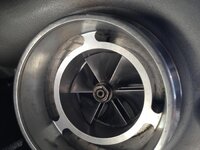Steve93Talon
15+ Year Contributor
- 1,629
- 174
- Jan 20, 2005
-
Philly Burbs,
Pennsylvania
Curious if everyone that's putting these together themselves is just throwing the new wheel into their CHRA, or are you re-balancing it? We just put together a friend's EVO IX billet 20g and as soon as it goes into boost the wheel is dragging on the compressor housing. The turbo was in perfect shape before it was disassembled, compresor housing is seated correctly, spins freely, minimal side to side play, no in-out, shaft nut is still tight. Everything points to a balance issue. I've built plenty of 16g and 20g's with cast wheels in the past without re-balancing and they were fine, wondering if it's an issue with this particular brand, or maybe the taller blade height...


















